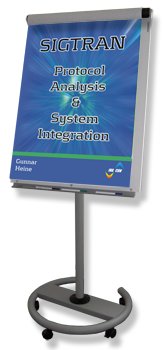 SIGTRAN - Protocol Analysis & System Integration
SIGTRAN - Protocol Analysis & System Integration
[2-day course, Euro 2,350.- (net) per participant]
 Training Course Description
Training Course Description

- This training course addresses the needs of everybody who needs a detailed understanding of SIGTRAN.
- The training course starts with an introduction to SIGTRAN and the related protocols and continues with the description of the QoS-requirements on SIGTRAN.
- This part ends with a comparison of SIGTRAN and its alternatives (e.g. SIP, DIAMETER, …) on different interfaces.
- The following part reviews important characteristics of the CCS7-protocol suite that SIGTRAN shall more or less replace. Focus is on SPC- and Global Title based routing procedures, SLS-based load sharing and MT-2 and MTP-3 management procedures.
- The training course continues with a detailed consideration of the SCTP. Among others we evaluate in detail the SCTP association establishment and security threats for SCTP.
- Special focus is on SCTP association management procedures like HEARTBEAT, RTO-calculation, data transfer and acknowledgement (SACK) and congestion control.
- This part concludes with the discussion of the optimum setting of SCTP-parameters like RTO.Initial, SACK-Delay, Path.Max.Retrans or RTO.Alpha.
- The next chapter evaluates in detail various important adaptation layer protocols like M2PA, M2UA, M3UA and SUA.
- This part includes the discussion of the N+K-redundancy concept and the related ASP-management procedures.
- The final chapter deals with SIGTRAN problems and testing. Major focus is on the discussion of SIGTRAN-operation across so called “battlefield”-networks using IPsec and through NAT’s.
- The training course concludes with the discussion of suitable SIGTRAN-testing procedures for vendors and operators.
 Some of your questions that will be answered
Some of your questions that will be answered
- How can an IP-network be reliable and secure enough in the first place to convey critical and confidential CCS7-information?
- Which address information is used within and among CCS7-networks to route information between adjacent nodes and end-to-end?
- Are there any means for load sharing among CCS7-links?
- What is the best adaptation layer protocol for our implementation? Shall we use M2PA, M2UA, M3UA or SUA?
- Which security mechanisms does SCTP support?
- Which packet format and chunk types does SCTP define and what are they used for?
- How does SIGTRAN mimic classical CCS7-parameters like OPC, DPC, SLS, SLR or DLR?
- How does the network layout differ between classical CCS7 and SIGTRAN?
- In which way does SIGTRAN provide for link supervision as CCS7-does?
- Does SIGTRAN support load sharing? If yes, is it more flexible than load sharing in legacy CCS7?
- In which way does SIGTRAN provide for CCS7-management procedures likes Change Over / Change Back (COO / CBD)?
- Is there a link establishment procedure in SIGTRAN comparable to the CCS-link establishment procedure through SLTM / SLTA?
- Which test procedures can be recommended upon SIGTRAN-commissioning?
- How well does SIGTRAN operate through NAT’s and NAPT’s?
- Can SIGTRAN operate with IPsec?
- What are the optimum settings for the different SCTP-parameters like for example RTO.initial, RTO.Min and Max or HB.interval under which conditions?
- What are typical error situations that SIGTRAN-enabled networks will encounter?
 Who should attend this class?
Who should attend this class?
- Design and test engineers of SIGTRAN equipment vendors.
- Engineering staff of network operators who require inside knowledge of SIGTRAN network operation (e.g. TAC II and III)
- Everybody who requires detailed knowledge of SIGTRAN technology and network operation.
 Pre-Requisites
Pre-Requisites
- Good IP-knowledge. Previous exposure to design, operation and/or level 2 maintenance of IP-networks is necessary.
- Good CCS7-knowledge. Previous exposure to design, operation and/or level 2 maintenance of CCS7-networks is necessary.
 Training Course Target
Training Course Target
- After the training course the student is enabled to perform sophisticated network analysis in SIGTRAN-enabled networks and to nail down typical network failures.
- The student can be assigned to any SIGTRAN-related engineering task in design, test, implementation or validation projects.
 Training Course Duration
Training Course Duration
- 2 days
v1.501
ℹ️ Try out the updated search below!
Search:
More Info:
Detailed ToC of this training course
Schedule of this training course
Extract of this training course
Buy this book
Buy this book as eBook
INACON eBooks
Please have a look at our full offer

